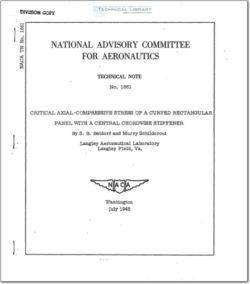NACA-TN-1661

- Version
- 226 Downloads
- 670.80 KB File Size
- 1 File Count
- December 4, 2015 Create Date
- December 4, 2015 Last Updated
National Advisory Committee for Aeronautics, Technical Notes - Critical Axial Compressive Stress of a Curved Rectangular Panel with a Central Chordwise Stiffener

The theoretical critical stress is derived for a simply supported
curved rectangular panel in axial compression having a central chord—
wise stiffener offering no torsional restraint. The results are
presented in the form of computed curves and a table.
Because a panel of moderate or_large_curvature buckles in com—
pression at a stress considerably below the theoretical value, a
method is suggested to aid in determining the critical stress for use
in design.
A simplified method was recently developed for determining the
theoretical buckling stresses of unstiffened cylindrical shells under
various loading conditions (references 1 and 2). In the present paper
the theory is extended to include stiffened shells (appendix B), and
the particular case of curved_rectangular panels in axial compression,
reinforced by a centrally located chordwise stiffener of zero torsional
stiffness, is treated in detail (appendix_C). Numerical results-for
this case are given in figures and a table. Because tests show that
unstiffened curved panels in compression.buckle at a load considerably
below the theoretical (see reference 3), a procedure is suggested to
permit the estimation of the actual critical stress of a rectangular
panel with a central chordwise stiffener.
The critical stress for a curved plate with a central chordwise
stiffener is conveniently computed by the use of the standard buckling
equation for a_curved plate (see equation in fig. 1) with the buckling
coefficient lb: for the unstiffened plate increased by an amount Akk
due to the presence of the stiffener. The criticaléstress coefficient“ kx
for an unstiffened curved late of various aspect ratios may be obtained
from figure 1. Figure 1(a gives the variation of kx with aspect
ratio for a flat plate (Z = 0); whereas figure l(b) gives kx for
curved plates. The increase_in critical—axial—stress coefficient Ah:
due to the presence of the stiffener is given in figure 2. The
curves in figure 2(a) give the maximum possible increase in critical
stress and apply when a stiffener is used for which the stiffness is
equal to orLgreater than the critical stiffness, that is, the value of
stiffness beyond which a further increase does not cause any increase
in the buckling stress. Figure 2(b) can be used to find the increase
in critical stress when the stiffness is below the critical value.
| File | Action |
|---|---|
| naca-tn-1661.pdf | Download |

Comment On This Post